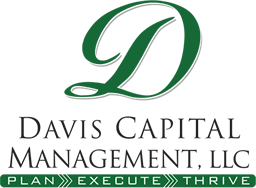You Can’t Plan for the Future Without Seeing the Big Picture
Setting up a strong financial future requires taking a close look at your current financial position and continuously monitoring variables like changes in income, evolving goals and fluctuation in the market.
Similar to how CPAs will do a valuation for business owners, Davis Capital Management will create a personal financial statement. This statement will assess your personal net worth and cash flow to get a bird’s-eye view of your overall financial picture.
Once we have a personal financial statement, we can integrate your current financial position with your future goals. That integration isn’t a one-time process. Rather, it’s a fluid process aimed at keeping your long-term financial plans at the forefront of every decision. We use your financial statement as a benchmark. Then we continuously evaluate and monitor your financial health to track progress and identify if any improvements can be made.

You Can’t Plan for the Future Without Seeing the Big Picture
Setting up a strong financial future requires taking a close look at your current financial position and continuously monitoring variables like changes in income, evolving goals and fluctuation in the market.
Similar to how CPAs will do a valuation for business owners, Davis Capital Management will create a personal financial statement. This statement will assess your personal net worth and cash flow to get a bird’s-eye view of your overall financial picture.
Once we have a personal financial statement, we can integrate your current financial position with your future goals. That integration isn’t a one-time process. Rather, it’s a fluid process aimed at keeping your long-term financial plans at the forefront of every decision. We use your financial statement as a benchmark. Then we continuously evaluate and monitor your financial health to track progress and identify if any improvements can be made.
What Your Personal Financial Statement Includes:
Your personal financial statement includes an in-depth analysis of the two following sections:
Balance Sheet: The balance sheet summarizes your assets, like cash or investments, and liabilities, including debts or loans. That information can then be used to determine your net worth by calculating the value of assets less the amount of liabilities.
Income Statement: The income statement analyzes the flow of income and expenses that influence your current financial position. The income portion outlines all sources of income, including salaries, bonuses, and dividends. The expense section details any regular debits, like insurance premiums, grocery bills, and utilities.
What Your Personal Financial Statement Excludes:
Your personal financial statement excludes the following:
Loaned Items: Since you don’t own loaned assets, they aren’t included in your personal financial statement. One exception would be if you own a property and rent it out to others. In that case, the value of the property would be included in your report.
Personal Belongings: Typically, furniture and other home goods are not listed as assets on a financial statement because they cannot be easily made liquid to pay off a loan. However, some high-value personal belongings, like jewels or antiques, can be included if a professional evaluation confirms their value.
Company Assets: Unless you have direct and personal responsibility for a company, company assets, and liabilities are excluded from your personal financial statement. However, if you guaranteed the loan for your company, that loan would be included in your personal financial statement.

